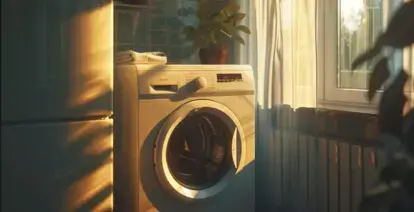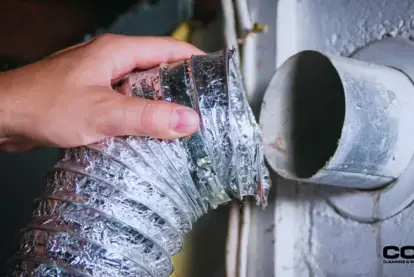
How to Clean a Dryer: A Step-by-Step Guide
Contact COIT for a professional cleaning!
Clogged dryers are the leading cause of household fires. In fact, according to a study released by the National Fire Protection Agency (NFPA), from 2010-2014, firefighters responded to almost 16,000 house fires, 92% of which involved clothing dryers.
So, how do clogged vents cause fires? Simply put, dryer vents work by trapping lint, dust, and debris from clothing as it’s drying. A properly functioning dryer is able to circulate heat and move the air through the duct system and to the outside. When vents go uncleaned and are left to collect lint, they can become clogged and restrict necessary airflow. As a material, lint ignites quickly, and without anywhere to go, this trapped heat and accumulated lint can become a real fire hazard.
Although a seemingly simple task, lint trap cleaning is easy to forget after each load of laundry. Even then, dryer maintenance goes beyond ensuring a clean and clear lint trap. In this article, we’ll provide practical tips and guide homeowners through the process of dryer vent cleaning to ensure maximum efficiency and prevent fires.
Why Cleaning Your Dryer is Essential
Neglecting to clean your dryer is a major fire hazard. For the protection of you, your family, and your home, it’s imperative to maintain a clean and clear dryer ventilation system. Beyond the potential for housefires, clogged/improperly functioning dryers reduce efficiency, can contribute to unpleasant household odors, and, because they have to work harder to get the job done, can cause higher energy bills.
Here are just some of the benefits of maintaining a clean dryer:
- Prevent dryer fires
- Increase the efficiency and lifespan of your dryer
- Prevent bad odors (musty smells) related to clogged dryers
- Save energy by limiting the amount of time it takes to fully dry clothing
- Less time in the dryer = less wear and tear on clothing
- Improved indoor air quality and decreased potential for mold-related musty smells
Step-by-Step Guide to Cleaning Your Dryer
Regularly cleaning the lint trap after each load of laundry is important but so is performing a routine deep clean of your dryer’s ventilation system. If you notice something isn’t working quite right or perhaps there’s a foul odor coming from your dryer, it may be worth doing a thorough clean and inspection of your appliance. It’s recommended that dryers are cleaned thoroughly at least once a year. Below you’ll find more helpful tips and a step-by-step guide to clean your dryer.
Step 1: Unplug/Turn Off Your Dryer
For safety reasons, you’ll first want to unplug your appliance or, if you have a gas dryer, turn off the valve before cleaning. Be sure to read the manufacturing guidelines beforehand as not all dryers are made the same and may require specific maintenance procedures.
Step 2: Unscrew Vent Connecting Clamps
Your dryer is connected to your wall via an exhaust hose. Before fully moving your machine away from the wall in order to clean it thoroughly, you’ll want to first unscrew the clamps connecting the hose to the wall.
Step 3: Move Your Dryer and Inspect for Damage
To access and inspect all sides of your dryer, carefully pull it away from the wall after disconnecting it from the ventilation duct. After the dryer is out of the way, you can inspect the vent and check for any immediate obstructions or damage.
From there, determine if the pipe needs replacing or simply needs to be cleaned out. Using a vent brush, remove any immediate blockages. To see further into the vent, use a flashlight to inspect for damage. If you notice a large obstruction that is out of your immediate reach or great amount of structural damage, it may be time to replace or call in the professionals for help.
Contact COIT to schedule a professional dryer vent cleaning!
Step 4: Inspect the Ventilation Duct from the Outside
As mentioned, your dryer works by circulating air to the outside. Locate your home’s dryer vent from the outside (likely on the wall directly behind your dryer). Remove the protective covering and, using a brush, clean out any lint from the vent. Inspect the inside of the vent using a flashlight. Again, if you notice a larger blockage or internal damage, you will want to consider replacing the ducts or having them professionally cleaned.
Step 5: Reattach the Vent and Push Back into Place
After cleaning the vents thoroughly or replacing the duct altogether, reattach the ventilation clamps and push the dryer back into place.
Step 6: Clean the Lint Trap
Remove the lint screen from the lint trap. Using your hands or a dryer sheet, remove the initial layer of lint from the screen. Using a vent brush and a vacuum, remove any excess lint from within the lint trap cavity, which can also become clogged with lint over time.
Step 7: Clean the Dryer Drum
Dryer drum cleaning is an important step in routine maintenance. Simply vacuum up any immediate dust or debris. Then, using an all-purpose cleaner or a damp cloth, wipe down the inside of the dryer. To eliminate the possibility of excess moisture and mildew, leave the dryer door open after each load of laundry so that it can air out.
Step 8: Turn On/ Plug Your Dryer Back In
After cleaning, turn on your dryer and give it a test run to ensure everything is functioning as it should. If you notice something still isn’t quite right, or a smell is persisting, consider calling COIT to do a deeper inspection of your appliance and get to the root of the issue.
Regular Maintenance Tips
Well-maintained dryers not only do a better job of drying clothing, but also reduce the chances of a house fire. For these reasons, it’s crucial to establish regular cleaning habits to promote dryer longevity.
Although it’s recommended to perform a deep cleaning of your dryer at least once a year, you should be cleaning out the lint screen after each load of laundry. Here are some dryer cleaning tips to keep your appliance in top condition:
- Know your dryer’s capacity limits and don’t overload your laundry. Overloading your dryer not only means longer dry times and higher energy bills, but can also contribute to higher levels of lint.
- If your dryer currently has a plastic or aluminum ventilation duct, consider replacing it with a metal one that will last longer and withstand more heat.
- Place your dryer on stable ground to ensure proper heat distribution.
- Don’t forget to inspect your outdoor duct for potential blockages or damage.
When to Call a Professional
As an intricate appliance, dryers require a bit of maintenance to upkeep. From clogged ventilation ducts and worn exhaust pipes, it’s important to ensure everything is working properly to increase the lifespan of your dryer and prevent house fires. While it is possible to perform a deep cleaning of your dryer on your own, there are a few signs you may want to go to the experts for help.
If you notice a bad smell that won’t go away even after you’ve gone through the cleaning steps listed above, this may be a sign of mold or perhaps decay (given the warm environment, critters will often nestle their way into air ducts). Without proper equipment to inspect the inner workings of the appliance or ducts, it’s tough to tell what the real issue is.
Expert technicians at COIT have the knowledge and the resources required to inspect your dryer with professional-grade precision. We’ll not only be able to tell you what’s causing your dryer issues, but also provide practical solutions to ensure the safety of you, your family, and your home.
To schedule your inspection or routine dryer cleaning, contact COIT today.



